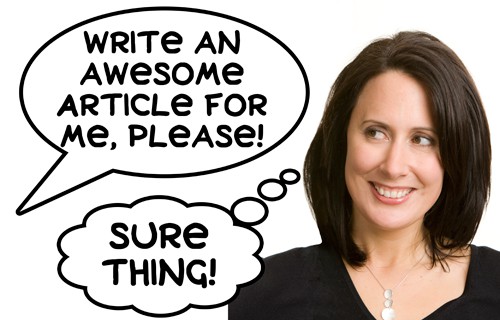Have you noticed how some movies have you glancing at your watch after just 45 minutes?
Yet other movies have you on the edge of your seat for nearly 2.5 hours.
So what’s the ideal length of a movie? I’d say that it needs long enough to do the job. When a movie is considered “too long” it’s usually because the plot wasn’t very strong, or the pace of the movie was too slow.
The same thing applies in article writing
In article writing, the article needs to be long enough to do its job
After all, there’s no point rambling on for the sake of it, to meet some imaginary word limit. Likewise, if you make an article too short so it can fit into a teeny-tiny little space, you might confuse your readers if you don’t give them enough information.
The articles on this blog vary dramatically: some are just 400 words long; others are nearly 3,000. I write my articles not to suit a word limit, but to do the topic justice. And for most of the time, following that approach that will be fine: there are only a couple of instances where word count matters.
The only times when word count matters are:
(a) Search-engine optimised website content
The search engines like information-rich websites with unique, quality content. So if search engine rankings matter to you, it’s worth sticking to their guidelines. And for good rankings you need a minimum of 250 words of optimised copy per web page. That’s the absolute minimum; if you can get the word count to over 500 words, that’s even better.
(b) Magazines and other print publications
If you’re submitting an article to a magazine or other print publication, you’ll usually have to write to a strict word count. That’s so that your piece will fill the space available (but without overflowing).
Those are the most common places where there’s a word limit… the rest of the time, just make sure that your article is long enough to do its job well. And a good article has much in common with a good movie.
What are the components of a good article?
A good article has the following elements:
1. Structure
An article needs to be well-structured, which means that the topic needs to flow. You can’t jump around all over the place and expect readers to follow… otherwise it’ll be like one of those confusing ‘flashback’ style movies. And that’s not a good thing in marketing!
How do you make sure that your article has a good structure? A bit of time spent outlining it (before you start writing it) will help your information flow. I outline all my articles first, and it stops me from writing myself into corners and dead-ends. 😉
2. Pace
Your article needs to stride along at an appropriate pace. On one hand, you don’t want to ramble on about something too much, but you don’t want to be so brief that no-one knows what you’re talking about. Again, if you spend some time outlining your article, it’ll help with the pace.
3. “Scenes”
Movies don’t (usually) have the same camera angle and same set for the entire duration. There’ll be indoor scenes. Outdoor scenes. The story’s broken up into segments to keep you interested.
The same applies in article writing, and the technique you use to achieve this is sub-headings. Notice how this article has sub-headings throughout to pull you through it, and to hold your attention. This is much more engaging than writing one long, endless article without an intermission!
4. You-appeal
I don’t like horror movies. Or sci-fi movies. And I’m not big on Westerns either.
You probably have your movie likes and dislikes too.
And when it comes to reading, we all have different topics that interest us. Thus it makes sense that when we’re writing, we’re totally focused on writing about topics that our audience (customers and prospects) will enjoy.
Even more importantly, we need to write using the kind of words and kind of language they’ll enjoy reading. All too often, business owners make the mistake of using industry jargon and buzzwords in their articles, and this is a big turn-off to most readers. The business owner thinks that using long words will make them look good… but actually it makes it very hard to understand what they’re actually saying. Talking in layman’s terms is vital… after all, have you ever heard anyone complain that something is too easy to understand? Neither have I! 😉
5. Editing
Movies that go on and on and on are boring. So are articles that ramble. And the mistake that many novice writers make is to stuff their article full of irrelevant words.
My tip: after you’ve written the article, leave it for a day. Look at it with fresh eyes the next day, and get busy with the ‘delete’ button. Edit out any words or sentences that aren’t needed.
Think of it like the cutting room: in the movies they don’t show every minute of film footage. Nope, most of it’s left on the cutting room floor, so that the cinema-goer can see just the best bits. That’s what makes a movie compelling – and also an article.
Summary
There’s usually no ‘ideal’ length for an article – it simply needs to be long enough to do its job well.
To achieve that, begin by outlining your article: that will help you structure it well, and keep the writing moving along at a nice pace.
Break up the article with sub-headings, and make sure that you’re using language that your audience will understand.
Finally, edit the article so that any weak or irrelevant parts are deleted. That way your audience will be so enraptured with what they’re reading, they won’t even get a chance to finish their popcorn. 😉
PS. Yes, I can help you with article writing!

Read more about article writing services from Cornelia Luethi.
“Cornelia writes the text for our newsletters and some website updates. She did a great job of taking our rambling thoughts and turning them into professional, easy to read copy. We’ve had a good reaction and it has had the desired effect of prompting some existing clients into starting new projects with us.” – Nigel Smith, Transformer Design



